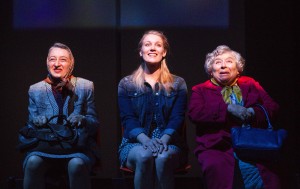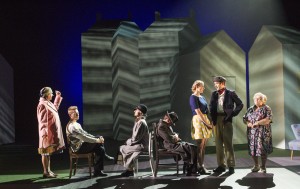By Peter Maddern
It doesn’t get more anonymous and uninspiring than the street where Neighbourhood Watch takes place. Director, Julian Meyrick and designer Louise McCarthy’s set is populated only by white windowless low rise blocks and an eclectic racial mix of people not doing much.
Its 2007 when the play opens with 20 something Catherine (Eleanor Stankiewicz) wiling away the time with her flatmate, Ken, both pursuing dreams in the entertainment industry but little else. Across the road is widowed Hungarian Ana (Miriam Margoyles), a woman we who come to see is as colourful and well-worn as the dress she wears.
Both her and Catherine’s lives are frozen, the former from the deep scars of hardship and loss especially during the war and the latter from separation from her boyfriend. Over time they come to befriend and help each other start to move on in their lives.
In many ways this is a difficult play to fully enjoy. For starters it is very long – 2 ½ hours (including interval), punctuated repeatedly by innumerable scene and set changes that tend to disrupt, distract and elongate the narrative. By some measure the structure requires some of this with a number of flashbacks, primarily to Ana’s youth, mainly in the war, where Stankiewicz takes on Ana’s role, but a severe tightening of the text would not go astray.
As delightful as the tall, barelegged Stankiewicz is to observe, her character is not one with which we easily find a connection. Her dissiness often strays into selfishness rather than being a product of love lost distraction and the development of her relationship with Ana at times lack credibility – why would anyone sleep on the couch of a neighbour when her own bed beckons 15 metres away?
The plucked from Hollywood ending and the extraordinary lack of empathy with ‘friends’ in the street somewhat also belies Meyrick’s note that playright Lally Katz’s approaches this as rather more of an observer than ‘coldly omniscient literary god’. Where Neighbourhood Watch does succeed is as an exposition of the worlds of isolation we effectively choose to live in notwithstanding ever greater urban congestion.
Anyway, season subscribers and current ticket holders should not lament for all is by no means lost. Miriam Margoyles delivers one of the best performances seen at the Playhouse for many years. Her broken English does not hide a life of pain and yet a yearning for friendship to ease her load, to avoid ‘the shame’ and as a means to impart her wisdom to a ‘baby horse’. Her relationship with her feisty dog, ‘the Bella’ is as amusing as it is consistent with her disposition, especially as displayed to Milova (Eugenia Fragos), the Serbian who travels from afar each day in the hope to share one coffee with her. Margoyles is a delight not to be missed.
Nic English similarly pleases in various roles, all as the embodiment of the ideal catch. James Smith’s Ken is as interesting as any, a man of conviction and generosity, traits that get lost in Catherine’s confusion and Fragos’ Milova is fun as an intense bundle of misunderstood frailty.
Challenging writing styles should be embraced but without Margoyles being in top form Neighbourhood Watch may have proved to have been a long night wandering the street.
Kryztoff Rating 3K




Recent Comments